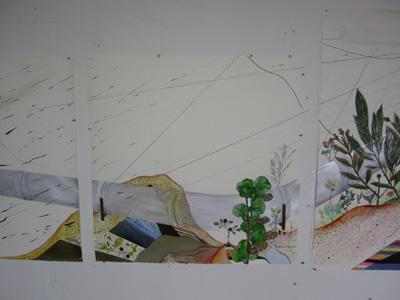Jason Middlebrook
dal 9/12/2003 al 7/2/2004
Segnalato da
9/12/2003
Jason Middlebrook
Els Hanappe Underground, Athens
APL#2 (Alaskan Pipe Line) - Drawings. In approximately 30 drawings of varying sizes, Jason Middlebrook had depicted the 800-mile Alaskan Pipeline at a scale of 2,5 miles to 1 foot. The rendering of the pipeline runs through each drawing and wraps around the entire exhibition space, encompassing the last third of the APL.

(Lives and works in New York)
APL#2 (Alaskan Pipe Line) - Drawings
In collaboration with New York gallery Sara Meltzer where the first part (two thirds) of the show, 'APL#1', opened on October 18.
artforum critics' picks of APL#1
In approximately 30 drawings of varying sizes, Jason Middlebrook had depicted the 800-mile Alaskan Pipeline at a scale of 2,5 miles to 1 foot. The rendering of the pipeline runs through each drawing and wraps around the entire exhibition space, encompassing the last third of the APL. The artist begins with the depiction of Prudhoe Bay, the original discovery site of oil in Alaska, and works his way south to the Port of Valdez where the oil is piped into ships at the port and delivered to the continental United States.
Though the pipeline remains a constant in each drawing, it becomes a springboard to explore recurrent themes in Middlebrook's works: geology, ecology, art history, and political economies. The pipeline acts as a metaphor - an artery, a lifeline, and a sculpture that can bind these diverse aspects of the work together.
Middlebrook uses the visual theme of a core sample to examine the layers of effects the APL has on its surrounding environments. Flora and fauna are presented and labeled as if catalogued. Flowers grow along the base of the pipe in one drawing, the pipe obliterates a Bald Eagle in another. Alongside these natural elements, Middlebrook presents abstractions of oil company insignias. The juxtaposition of imageries calls into question the Valdez oil spill, one of the largest environmental disasters of our time, and the greater consequences of the world's energy competition.
Middlebrook also relates the APL to the earthworks of the 1970s, considering it to be an earthwork of its own right. He explores works by Michael Heizer, Nancy Holt, and Christo, among others, placing them in interaction with the pipeline. Middlebrook both celebrates and critiques the outputs of the United States and considers the APL to be a symbol of American identity. It stands for progress, destruction, accomplishment, and a system that must be reconsidered.
Underlying throughout Middlebrook's representation of the APL is the United States', in fact, the world's dependency on and consumption of crude oil. The pipeline stands for global commerce and communication, and often the lack thereof signaling the need for alternative sources of energy in order to sustain a responsible future.
Els Hanappe Underground
Melanthiou 2, Psyrri
Atene



